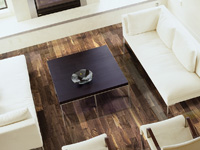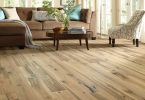 (NC)—According to hardwood flooring experts, the process of selecting your new floor should lead you through five common steps – choosing your colour, whether you require solid or engineered flooring, the species and grade, width and finally gloss level.
(NC)—According to hardwood flooring experts, the process of selecting your new floor should lead you through five common steps – choosing your colour, whether you require solid or engineered flooring, the species and grade, width and finally gloss level.
1. Choose your colour.
“We’ve found that today the number one consideration for consumers is selecting the right colour for their flooring to match their decors,” said Tom Gormley, President of Silhouette Hardwood Flooring.
Typically, hardwood flooring manufacturers offer a series of standard popular colour choices. Often these stain colours aren’t exactly what discerning consumers are looking for and they spend the next days and weeks searching different manufacturers for that particular elusive stain colour that will harmonize perfectly with their home design.
Canadian-based manufacturer Silhouette Hardwood Flooring has revolutionized this process by offering clients customized colours for their flooring with its exclusive “Designer colour match” system.
“We can easily match any color you see offered by most of our competitors at no additional charge,” explained Gormley. “Even if you have a unique color in mind, simply supply your local Silhouette dealer with any kind of sample to match and we will reproduce it to create your one of a kind beautiful new floor.”
2. Determine whether you’re using solid or engineered flooring.
Solid flooring must be nailed or stapled into an existing wood subfloor and is only recommended on or above the grade level (soil line) around your home.
Engineered flooring’s construction allows it to be installed over virtually any type of subfloor whether above, on, or below the grade level. Silhouette’s Symmetry Engineered flooring, for example, has the most versatile design, allowing it to be nailed, stapled, fully glued-down, or even floated.
3. Choose your preferred species and grade.
Examine the natural colour of each species, their distinctive grain patterns, grades and visual characteristics such as knots, and mineral streaks to find what appeals to you. Also consider the relative hardness of the different species. If you have an active high traffic household or a large pet, harder species may be an option as they will show less dents and traffic patterns.
4. Choose your board width.
Narrow boards, or strip flooring, performs well and has a certain appeal particularly in smaller rooms, while wide boards are often perceived as being of higher value, and have greater appeal in larger rooms. Up until now many hardwood dealers recommended against choosing flooring wider than 3 ¼”, because of fear that the floor would develop unsightly and unhealthy gaps over time due to uncontrolled swings in relative humidity within a home.
Gormley explained this is no longer the case thanks to the added protection of Silhouette’s unique Contour Guard finishing process which envelopes each of its floorboards to eliminate any possible unattractive and unhealthy effects from these gaps.
5. Choose your gloss level
The final choice is the degree of light you wish your floor to reflect. A Semi-Gloss finish reflects approximately 50 per cent of the light shone upon, while a simulated-oil look reflects approximately eight per cent and a satin-gloss finish reflects at a 30 per cent rate.
More information on the latest in premium hardwood flooring is available at www.silhouetteflooring.com.
www.newscanada.com
Latest posts by Canadian Home Trends (see all)
- Layer Up – Wrap Your Bathroom In Light - January 2, 2026
- The Power of Rest: Elevate Your Wellness with Better Sleep - January 2, 2026
- VERSATILE KITCHEN DESIGN - January 2, 2026






